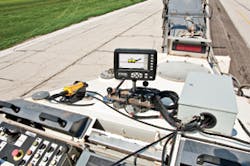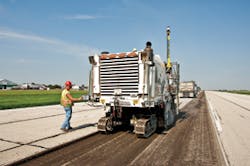Let’s be clear from the start. The Ohio State University located in Columbus is not the same as Ohio University, located in Athens, Ohio. Most anyone living in Ohio, will quickly correct the mistake, if it’s made. And don’t forget the word “the” in front of Ohio State University. It is The Ohio State University (although curiously, it is referred to as OSU, not The OSU).
Founded in 1870, OSU is the second-largest university campus in the US and is one of only a few universities to have both a department of aviation and a busy airport. In fact, the OSU Airport ranks in the top five airports in Ohio in the number of takeoffs and landings. It is located about 5 miles from the main campus in Dublin, OH.
Recently, the Columbus-based highway and heavy construction contractor Shelly & Sands Inc. was selected to completely rehab one of the four OSU Airport runways. Considering the amount of air traffic, the university needed the project completed quickly, while satisfying the strict FAA quality requirements for grade, slope, accuracy, and smoothness. This was clearly a runway that couldn’t be out of commission for any longer than necessary.
Shelly & Sands was up to the challenge and implemented precision construction technology from Trimble to satisfy the time deadline, smoothness, and accuracy requirements. Precision Laser & Instruments Inc., the Trimble dealer in Monroe, OH, helped the company select the right system for its needs.
Considered a large contractor, Shelly & Sands employs about 600 seasonal workers and has around 400 full-time employees.
Layers of Work
“We began working on The Ohio State University Airport Rehabilitation, south runway, and ramp in May 2009 and completed the project on time in November,” states John Dowalter, survey manager for Shelly & Sands. “We first had to mill the existing asphalt to a variable depth of zero to 5 inches in multiple passes on the 6,000-foot runway.” Shelly & Sands had a subcontractor mill the old surface to a new design using the Trimble GCS900 3D system guided by a SPS930 robotic total station.
“After milling off the surface, we then went in and pulverized the remaining asphalt and sub-base to a 14-inch depth, then recompacted and regraded it,” Dowalter says. “And then we cement-stabilized the pulverized material to the 14-inch depth and regraded to subgrade.”
Between each of these processes there was grading-profile grading-to match the specs of the provided plan. The runway and ramp areas both had variable cross-slopes. “The complex grading that was required was made simple with the help of Trimble Grade Control Systems on both of our motor graders,” Dowalter says. “Both machines are equipped with Trimble GCS900 Grade Control Systems, allowing us to match the grading to the profile plan without errors or rework.” Trimble 5600 Robotic Total Stations and R8-2 GPS Receivers with Trimble TSC2 Controllers were used for project control and data collection.
Shelly and Sands’ subcontractor used its own Trimble GCS900 Universal Total Station system on its Wirtgen W 200 large-volume milling machine. The benefit of the 3D milling system was that the correct grade could be achieved the first time. Much of the required design spec was already cut by the mill before the grader came into the picture.
No Stringlines
“Even though stringlines were specced into the project, we eliminated the need for literally miles of stringline and easily saved a week’s worth of staking, because we were all using Trimble systems,” Dowalter says. “The engineering firm that developed the specs was, I guess, more old-school. They struggled at first in understanding the Trimble technology and its benefits. Initially, they were trying to dictate how we were to rebuild the runway, but we stuck to our guns as far as using the Trimble 3D systems and proved we could achieve the grade tolerances they were requiring.”
The FAA is very strict in its requirements for airport runways.
The engineering firm was not out of line with its concerns about achieving the tight grade tolerances. Understandably, the FAA is very strict in its requirements for airport runways. “We needed to hit the spec-plus or minus-a half inch,” states Dowalter. “On top of that, we were building a completely new profile grade for the runway that the engineers had created, which meant variable depth milling. Which meant, to meet this more complex profile, we couldn’t just set up the milling machine to mill 4 inches and let it head down the runway. We might be milling a half-inch at one point, get 500 feet down the runway and be milling 3 inches.”
The OSU Airport south runway rehab was completed in two phases and ramp rehab project was completed in five production phases. The runway was paved in four 25-foot-wide passes. The project also included such ancillary work as underdrains, perimeter underdrains, and constructing berms on the sides of the runway, as well as airplane tie-down features on the ramp area for longer-term idle planes.
Dowalter reports that the timelines for a couple of phases were extremely tight. “The Trimble Grade Control Systems really helped us out, since we were able to accurately hit the grade profile without needing to go back and regrade or do any corrections.”
Dowalter notes that historically, when working on an area that’s not graded correctly, there can be a lot of rework that will show up in the final paving. There may be pavement cutouts where milling and repaving becomes necessary. “With the Trimble systems, we avoided those headaches-even with the variable cross-slopes for the length of the runway.”
On Time, Money Saved
Shelly and Sands, as well as OSU, are pleased with the results of the south runway and ramp rehab-a key runway in a very active airport. The project was completed on time, so Shelly and Sands did not incur any of the $10,000-per-day penalties for being late.





